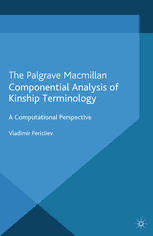
Componential Analysis of Kinship Terminology: A Computational Perspective PDF
Preview Componential Analysis of Kinship Terminology: A Computational Perspective
The Palgrave Macmillan Componential Analysis of Kinship Terminology A Computational Perspective Vladimir Pericliev Componential Analysis of Kinship Terminology AlsobyVladimirPericliev MACHINE-AIDEDLINGUISTICDISCOVERY:AnIntroductionandSome Examples PROFILINGLANGUAGEFAMILIESBYTHEIRKINTERMPATTERNS: AComputationalApproach Componential Analysis of Kinship Terminology A Computational Perspective Vladimir Pericliev BulgarianAcademyofSciences,Sofia ©VladimirPericliev2013 Softcover reprint of the hardcover 1st edition 2013 978-1-137-03117-4 Allrightsreserved.Noreproduction,copyortransmissionofthis publicationmaybemadewithoutwrittenpermission. Noportionofthispublicationmaybereproduced,copiedortransmitted savewithwrittenpermissionorinaccordancewiththeprovisionsofthe Copyright,DesignsandPatentsAct1988,orunderthetermsofanylicence permittinglimitedcopyingissuedbytheCopyrightLicensingAgency, SaffronHouse,6–10KirbyStreet,LondonEC1N8TS. Anypersonwhodoesanyunauthorizedactinrelationtothispublication maybeliabletocriminalprosecutionandcivilclaimsfordamages. Theauthorhasassertedhisrighttobeidentifiedastheauthorofthiswork inaccordancewiththeCopyright,DesignsandPatentsAct1988. Firstpublished2013by PALGRAVEMACMILLAN PalgraveMacmillanintheUKisanimprintofMacmillanPublishersLimited, registeredinEngland,companynumber785998,ofHoundmills,Basingstoke, HampshireRG216XS. PalgraveMacmillanintheUSisadivisionofStMartin’sPressLLC, 175FifthAvenue,NewYork,NY10010. PalgraveMacmillanistheglobalacademicimprintoftheabovecompanies andhascompaniesandrepresentativesthroughouttheworld. Palgrave®andMacmillan®areregisteredtrademarksintheUnitedStates, theUnitedKingdom,Europeandothercountries. ISBN 978-1-349-44076-4 ISBN 978-1-137-03118-1 (eBook) DOI 10.1057/9781137031181 Thisbookisprintedonpapersuitableforrecyclingandmadefromfully managedandsustainedforestsources.Logging,pulpingandmanufacturing processesareexpectedtoconformtotheenvironmentalregulationsofthe countryoforigin. AcataloguerecordforthisbookisavailablefromtheBritishLibrary. AcatalogrecordforthisbookisavailablefromtheLibraryofCongress. Contents ListoftablesintheAppendix vi Preface ix Acknowledgments xii 1 Introduction:thehistoricalbackground 1 1.1 General 1 1.2 Componentialanalysisofkinshipterminological systems:thebasicnotions 4 1.3 Goalsofcomponentialanalysis:‘psychological validity’vs.‘social-structuralreality’ 12 1.4 Componentialanalysisandalternativeapproaches 15 1.5 Summary 20 2 Problemsofcomponentialanalysis 22 2.1 Violationofconsistency:examplesfromtheliterature 23 2.2 Multiplesolutions 39 2.3 Summary 54 3 TheKINSHIPsystem 56 3.1 AnoverviewofKINSHIP 56 3.2 Thebasicalgorithm 59 3.3 Bulgarianre-analysedwithKINSHIP’s simplicityconstraints 70 4 Componentialanalysesofselectedlanguages 80 4.1 Introduction 80 4.2 Exercisesinmachinecomponentialanalysis 81 4.3 Summaryofresults 113 5 Conclusion 119 Appendix:Tables 123 Bibliography 172 Index 176 v List of tables in the Appendix 1.1 ComponentialanalysisofEnglishconsanguineals 123 1.2 RelationalanalysisofEnglish(afterWallace1970) 123 2.1 Nogle’scomponentialmodelofEnglish 124 2.2 Contrastsdemarcatinguncle 124 2.3 RedundancyinNogle’scomponentialmodelofEnglish (redundantcomponentsenclosedinbrackets) 125 2.4 Burling’scomponentialmodelofBurmeseandits redundancy(redundantcomponentsenclosedin brackets) 126 2.5 Cherryetal.’scomponentialmodelofRussianphonemes anditsredundancy(redundantcomponentsenclosedin brackets) 127 2.6 Spencer’sredundantmodelofthesystemoffivevowels/i, e,a,o,u/(redundantcomponentsenclosedinbrackets) 128 2.7 ComponentialschemeofBulgarianreferencetermswith dimensionset{sex,sex1stlink,affinity1stlink, generation,distance,affinity} 128 2.8 ComponentialschemeofBulgarianaddresstermswith dimensionset{sex,generation,generationlastlink,sex 1stlink,affinity1stlink,distance} 132 2.9 Norick’sredundantmodelofNiutaokinshipterms (redundantcomponentsenclosedinparenthesesand emptycellsinanglebrackets) 134 3.1 AsubsetofBulgarianconsanguinealkinshipterms 135 3.2 KintypesofcertainAmericankinterms 135 3.3 Determiningfeaturevaluesofkintypes 135 3.4 Determiningkintermcomponents 136 3.5 Contrastingfeaturesbetweenpairsofkinterms 136 3.6 Contrastswithˇciˇco 137 3.7 Simplestcomponentialmodel 137 3.8 Anothersimplestcomponentialmodel 137 3.9 Afullyredundantcomponentialmodel 137 3.10 Stylesofkintermdefinitions 138 3.11 ComponentialschemeofBulgariankintermsofreference andaddress 138 vi ListoftablesintheAppendix vii 3.12 TheuniquecomponentialmodelofBulgariankinterms ofreferenceandaddress 147 4.1 SimplestcomponentialanalysisofAmericanEnglish 149 4.2 SimplestcomponentialanalysisofSwedish(alternative1) 150 4.3 SimplestcomponentialanalysisofSwedish(alternative2) 151 4.4 SimplestcomponentialanalysisofIrish 152 4.5 SimplestcomponentialanalysisofSpanish 152 4.6 SimplestcomponentialanalysisofPolish(alternative1) 153 4.7 SimplestcomponentialanalysisofPolish(alternative2) 154 4.8 SimplestcomponentialanalysisofCzech 155 4.9 SimplestcomponentialanalysisofPersian 155 4.10 SimplestcomponentialanalysisofAlbanian (alternative1) 156 4.11 SimplestcomponentialanalysisofAlbanian (alternative2) 156 4.12 ComponentialanalysisofAlbanian(alternative3) 157 4.13 SimplestcomponentialanalysisofArmenian 157 4.14 SimplestcomponentialanalysisofTurkish(alternative1) 159 4.15 SimplestcomponentialanalysisofTurkish(alternative2) 160 4.16 SimplestcomponentialanalysisofTurkish(alternative3) 161 4.17 SimplestcomponentialanalysisofTurkish(alternative4) 163 4.18 ComponentialanalysisofSeneca 164 4.19 SimplestcomponentialanalysisofZapotec 165 4.20 SimplestcomponentialanalysisofPopoloca (alternative1) 165 4.21 SimplestcomponentialanalysisofPopoloca (alternative2) 165 4.22 SimplestcomponentialanalysisofPopoloca (alternative3) 166 4.23 SimplestcomponentialanalysisofPopoloca (alternative4) 166 4.24 SimplestcomponentialanalysisofPopoloca (alternative5) 166 4.25 SimplestcomponentialanalysisofPopoloca (alternative6) 167 4.26 SimplestcomponentialanalysisofHuave(alternative1) 167 4.27 SimplestcomponentialanalysisofHuave(alternative2) 167 4.28 SimplestcomponentialanalysisofHuave(alternative3) 168 4.29 SimplestcomponentialanalysisofHuave(alternative4) 168 4.30 SimplestcomponentialanalysisofHuave(alternative5) 168 4.31 SimplestcomponentialanalysisofHuave(alternative6) 169 viii ListoftablesintheAppendix 4.32 SimplestcomponentialanalysisofHuave(alternative7) 169 4.33 SimplestcomponentialanalysisofHuave(alternative8) 169 4.34 SimplestcomponentialanalysisofHuave(alternative9) 170 4.35 SimplestcomponentialanalysisofHuave(alternative10) 170 4.36 Analysedlanguagesandnumberoftheiralternative dimensionsetsandcomponentialmodels 171 Preface The notion of ‘system’ is central in all post-Saussurean linguistics, and componential analysis is the method for exposing the systems of lin- guistic entities. In componential analysis, the meaning (or value) of the entities forming a system is described as a conjunction of smaller components that are necessary and jointly sufficient to distinguish each entity in the system from all others. Componential analysis orig- inated in phonology, but the approach was naturally extended also to the other levels of linguistic analysis: grammar and semantics. Componential analysis of kinship terminology, which lies at the cross- roads of linguistics and anthropology, is the prototype example from semantics. The early influential work on kinship semantics by Lounsbury, Goodenough and others laid the foundations of the field and was fol- lowed by numerous attempts to reveal the semantic structure of kin termsinvarious‘exotic’languages,hopingtounderstandthemeaning and use of the terms, and more optimistically, to highlight the cate- gorization and world view of native speakers. The topic flourished for several decades, but as happens all too often in science, after this peak the method became somewhat less visible in published work. Never- theless the approach was not abandoned altogether: in linguistics, it continued to be quite regularly used in semantic analyses of various theoretical persuasions, and in anthropology, ‘formal analysis’ (as the componential method is usually referred to in anthropology) contin- uedtobeanindispensablepartofkintermstudies.Thispersistencein methodologyisunderstandableinsofarasrejectingthemethodbasically implies rejecting the fundamental idea of system in linguistics. Addi- tionally,thesemantic structurearrivedatby componentialanalysis, as is well known, is important for constructing dictionary definitions, for translationpurposes,andforhistoricalreconstruction. A major goal of the present book is to critically review previ- ous conceptions of the method and improve on previous practice of componential analysis of kin terms by setting the problem in a com- putational perspective. Two basic problems are isolated in previous work: the consistency of componential models, and their indetermi- nacy. Regarding the first problem, I will try to show, with examples ix
